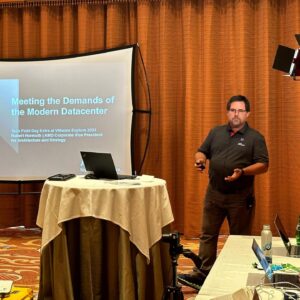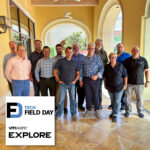|
|
 Robert Hormuth presented for AMD at Tech Field Day Extra at VMware Explore US 2023 |
This Presentation date is August 23, 2023 at 10:00-11:00.
Presenters: Chuck Gilbert, Glen Campbell, Jason Collier, Robert Hormuth
Delegate Panel: Allyson Klein, Andy Banta, Brian Knudtson, John White, Keith Townsend, Matt Tyrer, Mikael Korsgaard Jensen, Philip Sellers, Raphael Meyerowitz, Shaun Neal, W. Curtis Preston
Meeting the Demands of the Modern Datacenter with AMD
Watch on YouTube
Watch on Vimeo
Increasing demand for AI capabilities in your business means IT decision makers must adapt quickly or be left behind. How do you meet the AI demand though with constrained budgets, not to mention limited space and power in your data centers? The simple answer: consolidation. AMD has you covered with compute density, automation, and efficiency to free up the headroom required to pursue the AI demands on your business. AMD will walk you through the end-to-end ways AMD is ready to help your business succeed in the new era of pervasive AI.
Robert Hormuth, Corporate Vice President for Architecture and Strategy, presented at Tech Field Day Extra at VMware Explore US 2023 and discussed how AMD is addressing the demands of modern data centers. Hormuth highlighted AMD’s extensive portfolio, including the Epic CPU, Pensando DPU, and various data center GPU products, which are all designed to provide high-performance, energy-efficient compute solutions. With AI rapidly transforming businesses, AMD targets high compute density and optimized architectures to mitigate the limitations posed by budget, space, and power constraints in data centers. Hormuth underscored the significance of transitioning to heterogeneous computing to enhance energy efficiency and computational power.
Hormuth delved into the evolving landscape of AI, predicting a shift from ‘big brother’ AI, which influences human behavior, to ‘big mother’ AI, characterized by human assistance and nurturing capabilities. This evolution necessitates robust, heterogeneous compute systems. AMD offers a diverse array of products—from general-purpose CPUs to adaptive system-on-chips, accelerators, and custom solutions—that can cater to specific workloads and drive next-generation use cases. Hormuth emphasized the importance of enhancing user experiences and optimized business outcomes through these cutting-edge technologies while recognizing sustainability and energy efficiency as pivotal factors.
Addressing the intense demand for AI, Hormuth discussed the challenges data centers face, such as limited space and power. He highlighted how AMD’s Epic processors facilitate significant consolidation of older servers, resulting in enhanced performance per watt and space savings. Hormuth also mentioned that AMD’s new CPUs are designed to avoid the necessity of liquid cooling, allowing for efficient air cooling even at higher compute densities. To ensure smooth transitions to AMD’s advanced compute solutions, AMD collaborates with VMware to offer tools like the VMware Architecture Migration Tool (VAMP), which simplifies migration and optimizes workload performance in data centers.
Personnel: Robert Hormuth
Making Migration Easy: VMware Architecture Migration Tool with AMD
Watch on YouTube
Watch on Vimeo
The VMware Architecture Migration Tool (VAMT) was developed jointly by AMD and VMware to automate the migration of legacy VMs from Intel architecture to AMD architecture, with the goal of delivering a better user experience and better business value. This presentation and live demo will walk users through the features, functionality and roadmap for this quickly evolving open source tool.
Presented by Chuck Gilbert, Technical Director of Solutions Architecture for Architecture and Strategy, and Jason Collier, Principal Member of Technical Staff for Architecture and Strategy, AMD
In their presentation, Chuck Gilbert and Jason Collier explained the challenges involved in migrating virtual machines between different CPU architectures, particularly between Intel and AMD. Gilbert pointed out that while VMware’s Enhanced vMotion Compatibility (EVC) can smooth the migration process within generational families of CPUs by standardizing the feature sets across different hardware, it effectively locks performance to the lowest common denominator. Recognizing that live migration between Intel and AMD platforms remains complex due to differences embedded in the VMware portfolio, AMD and VMware co-developed the VMware Architecture Migration Tool (VAMT) to facilitate streamlined cold migrations. This tool not only supports migrations between Intel and AMD architectures but also within homogeneous or heterogeneous x86 environments.
The presentation emphasized that the VAMT simplifies the migration process by automating many traditionally manual steps through a combination of PowerShell scripting, scheduling, and task management. Operators are no longer required to individually handle each migration task as VAMT packages steps involved in cold migration, such as shutting down VMs, moving data, and ensuring VMware tools are properly functioning on the new environments. The tool also supports throttling and outage window scheduling, bringing efficiency and reliability to large-scale migrations. Jason Collier demonstrated the tool’s capabilities with a live demo, showcasing its ease of use and integration into existing workflows, making it a valuable resource for both small IT shops and large cloud providers.
Finally, the presentation highlighted that VAMT is an open-source project available on GitHub, inviting the community to contribute and suggest enhancements. Kudos were given to the fundamental aim of improving business value and user experience by simplifying VM migrations. AMD sees this tool as the starting point for broader infrastructural upgrades, potentially extending support in the future for other virtualization environments like KVM and Hyper-V, as well as cloud migrations. The overarching message was clear: VAMT represents a pragmatic, collaborative effort to solve real-world IT operational challenges, and AMD actively seeks user feedback to refine and expand the tool’s capabilities.
Personnel: Chuck Gilbert, Jason Collier








